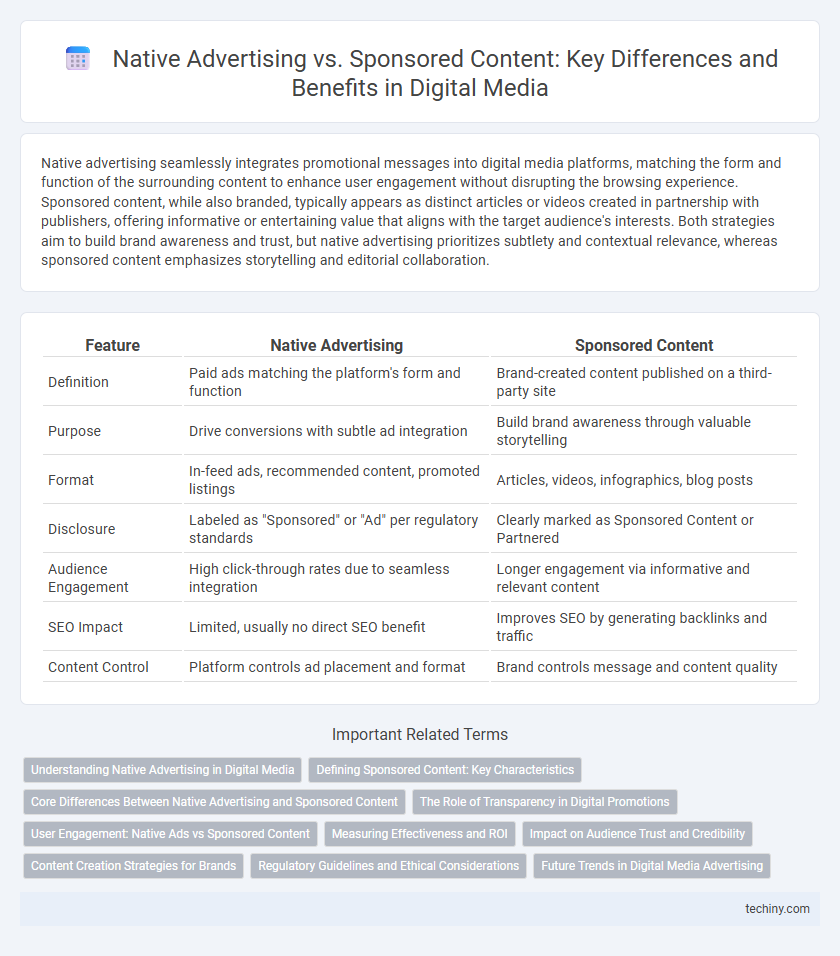Native advertising seamlessly integrates promotional messages into digital media platforms, matching the form and function of the surrounding content to enhance user engagement without disrupting the browsing experience. Sponsored content, while also branded, typically appears as distinct articles or videos created in partnership with publishers, offering informative or entertaining value that aligns with the target audience's interests. Both strategies aim to build brand awareness and trust, but native advertising prioritizes subtlety and contextual relevance, whereas sponsored content emphasizes storytelling and editorial collaboration.
Table of Comparison
| Feature | Native Advertising | Sponsored Content |
|---|---|---|
| Definition | Paid ads matching the platform's form and function | Brand-created content published on a third-party site |
| Purpose | Drive conversions with subtle ad integration | Build brand awareness through valuable storytelling |
| Format | In-feed ads, recommended content, promoted listings | Articles, videos, infographics, blog posts |
| Disclosure | Labeled as "Sponsored" or "Ad" per regulatory standards | Clearly marked as Sponsored Content or Partnered |
| Audience Engagement | High click-through rates due to seamless integration | Longer engagement via informative and relevant content |
| SEO Impact | Limited, usually no direct SEO benefit | Improves SEO by generating backlinks and traffic |
| Content Control | Platform controls ad placement and format | Brand controls message and content quality |
Understanding Native Advertising in Digital Media
Native advertising in digital media seamlessly integrates promotional content within the user experience, matching the form, function, and style of the platform's regular content. This approach enhances engagement and reduces ad fatigue by delivering ads that are relevant and less intrusive, often labeled subtly to maintain transparency. Brands leverage native advertising to build trust and foster organic interactions, resulting in higher click-through rates and improved campaign effectiveness compared to traditional display ads.
Defining Sponsored Content: Key Characteristics
Sponsored content is a type of digital media where branded material is seamlessly integrated into a publisher's platform, designed to match the style and tone of the surrounding editorial content. This form of advertising prioritizes storytelling and delivers value to readers by offering informative or entertaining content rather than direct sales pitches. Transparency is maintained through clear labeling, ensuring audiences recognize the content as paid promotion while engaging with it naturally.
Core Differences Between Native Advertising and Sponsored Content
Native advertising seamlessly blends promotional material with organic content, matching the platform's style and format to enhance user engagement without disrupting the user experience. Sponsored content is explicitly branded, often presented as a distinct advertisement or editorial piece with clear attribution to the sponsor, focusing on promoting the brand or product through informative or entertaining storytelling. The core difference lies in native advertising's integration and subtlety versus sponsored content's transparency and clear sponsorship disclosure.
The Role of Transparency in Digital Promotions
Transparency in digital promotions is crucial to maintaining consumer trust and ensuring ethical advertising practices. Native advertising, often blending seamlessly with editorial content, requires clear disclosure to distinguish paid promotions from organic content, preventing misleading impressions. Sponsored content mandates explicit labeling, enabling audiences to recognize promotional intent and make informed decisions, thereby enhancing credibility and compliance with advertising standards.
User Engagement: Native Ads vs Sponsored Content
Native advertising seamlessly integrates promotional messages within digital media platforms, resulting in higher user engagement due to its non-disruptive, relevant presentation. Sponsored content offers valuable information or entertainment under a branded banner, fostering user trust and creating long-lasting engagement through authenticity. Both formats leverage contextual relevance, but native ads typically generate quicker interaction rates while sponsored content drives deeper, sustained audience relationships.
Measuring Effectiveness and ROI
Measuring effectiveness in native advertising involves tracking engagement metrics such as click-through rates, time spent on content, and brand lift to evaluate user interaction and perception. Sponsored content effectiveness is often assessed through conversion rates, lead generation, and detailed analytics on audience demographics to determine targeted reach. Both strategies require integrating data from analytics platforms like Google Analytics and social media insights to calculate ROI by comparing campaign costs against direct and indirect revenue impacts.
Impact on Audience Trust and Credibility
Native advertising seamlessly integrates promotional messages within digital media content, often enhancing audience engagement but risking decreased trust if perceived as deceptive. Sponsored content, clearly labeled and providing genuine value, tends to maintain or improve credibility by fostering transparency and aligning brand messaging with audience interests. Studies show that transparency in sponsored content significantly boosts consumer trust compared to native ads that obscure sponsorship.
Content Creation Strategies for Brands
Native advertising blends seamlessly with platform content by matching its style and tone, enhancing user engagement through subtle brand integration. Sponsored content prioritizes informative or entertaining narratives crafted to align with audience interests while openly disclosing brand sponsorship to build trust. Effective content creation strategies for brands involve balancing authenticity with promotional value, using data-driven insights to tailor messaging that resonates organically within digital ecosystems.
Regulatory Guidelines and Ethical Considerations
Native advertising and sponsored content must comply with strict regulatory guidelines set by authorities such as the Federal Trade Commission (FTC), which mandates clear disclosure to prevent consumer deception. Ethical considerations emphasize transparency, requiring brands to distinguish paid promotions from editorial content to maintain audience trust. Failure to adhere to these standards can result in legal penalties and damage to brand reputation, highlighting the importance of ethical advertising practices in digital media.
Future Trends in Digital Media Advertising
Future trends in digital media advertising emphasize the integration of native advertising and sponsored content with advanced AI-driven targeting and personalized user experiences. Increasing consumer demand for authenticity drives brands to create seamless, contextually relevant ads that blend naturally with editorial content. Innovations in programmatic platforms and data analytics will further enhance measurement accuracy, enabling more strategic allocation of advertising budgets.
Native Advertising vs Sponsored Content Infographic

 techiny.com
techiny.com